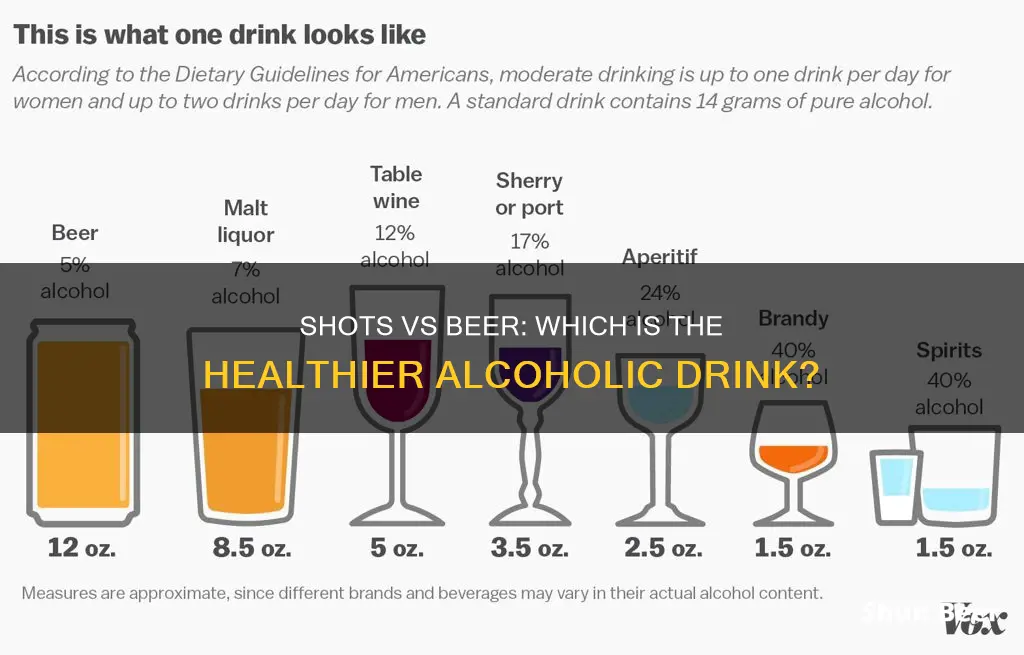
Alcohol is a recreational drug, and excessive alcohol use is associated with cancers of the liver, esophagus, colon, rectum, and larynx. While alcohol is not a healthy choice, some alcoholic drinks are better for you than others. Beer, for example, has more antioxidants than hard liquor, but liquor often has fewer or no carbohydrates. Beer also has more calories than liquor, making it easier to control your calorie intake with spirits. However, cocktails made with liquor can contain more than one or two servings of liquor, and it's easier to over-pour. Ultimately, the key to any health benefits from alcohol is moderation.
What You'll Learn

Beer has more antioxidants, liquor has fewer carbs
Beer and liquor have their pros and cons when it comes to health. Beer has more antioxidants, while liquor has fewer carbs.
Beer's Antioxidants
Beer contains phenolic compounds, or antioxidants, mostly originating from barley malt, with hops contributing the rest. Antioxidants are substances that protect against the oxidation of other molecules, and they may have a positive effect on health. Beer's antioxidants, for example, have been linked to a reduced risk of cardiovascular disease.
Liquor's Low-Carb Advantage
Liquor, on the other hand, often has fewer or no carbohydrates. Vodka, rum, whiskey, gin, and tequila in their pure form have zero carbohydrates, which is beneficial for keeping blood sugar levels stable. When liquor is combined with sugary mixers, however, it takes on more calories and carbs.
Overall Health Benefits of Alcohol
It's important to note that the health benefits of both beer and liquor are relatively small and depend on moderate consumption. Excessive alcohol consumption is associated with various cancers, liver disease, and other negative health outcomes.
Chelada Beers: Healthy or Harmful?
You may want to see also

Beer is less intoxicating
Beer has more antioxidants than hard liquor, but their overall effect is small. Beer contains phenolic compounds, or antioxidants, which originate mostly from barley malt, with the rest contributed by hops. One advantage of hard liquor is that many spirits have zero carbohydrates. Vodka, rum, whiskey, gin, and tequila in their pure form have no carbohydrates, which is beneficial if you're trying to keep your blood sugar from spiking.
Beer is also the healthier option when it comes to calories. The calories in a 12-fluid ounce bottle of regular beer vary from around 150 to 300. Lighter varieties usually run around 100 calories for 12-fluid ounces and are widely available in bars, restaurants, and retail markets. However, many bars offer pints (equivalent to 16-fluid ounces) with around 200 to 400 calories each. Liquor or spirits like vodka, gin, rum, tequila, and other "hard" alcohols are typically served in 1.5 fluid ounce servings, which will cost you about 100 calories.
When it comes to controlling calories, beer is the winner. It's just easier to control calories with beer. Unless you can enjoy liquor mixed with a non-calorie beverage (like seltzer) or over ice, it's just too easy to go overboard in those mixed cocktails.
Beer Drinkers: Healthy or Harmful?
You may want to see also

Beer is easier to track consumption
When it comes to alcohol consumption, it is important to monitor how much you are drinking. Beer is generally easier to track than shots in terms of consumption due to a few key reasons. Firstly, beer is typically served in standardized portions, such as a 12-fluid ounce bottle or a 16-fluid ounce pint. This makes it easier to keep track of how much you are drinking. On the other hand, shots or distilled spirits are often served in varying quantities, such as 1.5 fluid ounces for 80-proof liquor or 1 fluid ounce for 100-proof spirits. This discrepancy in serving sizes can make it more challenging to accurately monitor your intake.
Another factor that makes beer consumption easier to track is the rate at which it is typically consumed. Beer is usually sipped over a longer period, making it easier to pace yourself and maintain a moderate drinking level. In contrast, shots are often consumed quickly, one after the other, leading to a faster increase in intoxication levels. This rapid consumption of shots can make it challenging to keep track of how much alcohol you have had, especially if you are drinking in a social setting where drinks may be refilled or offered in quick succession.
The mixing of spirits with non-alcoholic beverages in cocktails further complicates tracking alcohol consumption. Cocktails can vary widely in their alcohol content, and it is not always easy to discern how much liquor is in a mixed drink. This ambiguity can lead to unintended overconsumption. Beer, on the other hand, is typically consumed in its original form, making it easier to know exactly how much alcohol you are ingesting.
Additionally, beer tends to be more filling than shots, which can serve as a natural limiter to consumption. As per Live Science, 12 ounces of beer is roughly equivalent to 5 ounces of wine or 1.5 ounces of liquor in terms of alcohol content. However, beer contains more volume and carbonation, leading to a greater sense of fullness. This can help individuals pace their drinking and be more mindful of their consumption.
Lastly, the social context in which alcohol is consumed can also impact how easily one can track their intake. Beer is often consumed casually or in social settings where drinking may be more relaxed and spread out over a longer period. In contrast, shots are often associated with rapid consumption, particularly in party or bar settings, making it more challenging to keep track of how much alcohol has been ingested.
Beer Bread: Healthy or Harmful?
You may want to see also

Beer is less likely to be abused
While both beer and liquor can be abused, beer is less likely to be abused for a number of reasons. Firstly, liquor has a higher alcohol content than beer, which means it can be deadlier faster and hit people unexpectedly. A shot of liquor can produce stronger effects than a can of beer, and it is easier to accidentally over-consume.
Secondly, liquor is often mixed with non-alcoholic beverages, which can make it easier to abuse due to its more pleasant taste. This also makes it easier to drink more liquor than intended, as the taste is masked. Beer, on the other hand, is typically consumed in its original form, making it harder to disguise the amount being consumed.
Thirdly, liquor is a faster and more effective way to get drunk than beer. For those who wish to achieve a state of drunkenness quickly and efficiently, liquor is the easiest and quickest way to do so. Beer, being milder, may result in a less intensive level of drunkenness, even when consumed in larger quantities.
Finally, the cultural factors surrounding the consumption of beer and liquor play a role in their potential for abuse. Beer is often consumed with meals and is associated with more moderate drinking patterns, particularly among older people, women, and those with higher incomes. Liquor, on the other hand, is more commonly consumed by heavier drinkers and is associated with binge drinking and underage drinking. These cultural factors influence the motivations and situational factors that affect the quantities consumed, which in turn impacts the potential for abuse.
While beer is less likely to be abused than liquor, it is important to remember that any form of alcohol abuse can have detrimental effects on a person's health. Excessive alcohol consumption can lead to liver damage, increased risk of certain cancers, and other serious health issues. Therefore, moderation is key when it comes to alcohol consumption, regardless of the type of drink.
Hard Seltzer vs Beer: Which is the Healthier Choice?
You may want to see also

Beer is less filling
Beer and liquor have their pros and cons when it comes to health. While beer has more antioxidants, liquor often has fewer or no carbohydrates. Hard liquor is distilled, making it much stronger than beer, with nearly 40% more alcohol by volume.
Liquor is also easier to consume quickly, especially in shot form, and can be masked by other ingredients in cocktails, making it easier to drink in larger quantities. Beer, on the other hand, is typically consumed more slowly and in smaller quantities, making it less likely to lead to overconsumption.
When it comes to feeling full, beer is more filling than liquor. According to Live Science, 12 ounces of beer is roughly equivalent to 5 ounces of wine or 1.5 ounces of liquor in terms of alcohol content. So, if you're looking to consume alcohol without filling up your stomach, liquor is the better option.
However, it's important to note that the feeling of fullness is not solely due to the alcohol content but also the volume of the drink. A standard serving of liquor is typically smaller than a standard beer, with one serving of liquor being 1.5 fluid ounces of an 80-proof liquor, while a "drink" of beer is usually defined as a 12-fluid ounce bottle.
Additionally, the calories in beer can vary widely, from around 100 to 400 calories per 12-fluid ounces, depending on the type and brand. Liquor, on the other hand, typically contains around 100 calories per serving.
Therefore, if you're looking to consume alcohol without feeling too full, liquor is a better option than beer, as it has a higher alcohol content per volume and is less likely to leave you feeling stuffed.
Beer and Health: Is NA Beer a Healthy Alternative?
You may want to see also
Frequently asked questions
It depends on what you mean by "healthier." If you're concerned about calories, then shots of hard liquor are less filling and have fewer carbohydrates than beer. However, beer has more antioxidants than hard liquor, which can have some health benefits. Ultimately, alcohol is not a healthy choice, and excessive consumption of any alcoholic beverage can lead to serious health issues.
Beer contains phenolic compounds and antioxidants, which can provide some health benefits. A 2011 study found that dark beers have more iron than pale or non-alcoholic beers. Additionally, moderate alcohol consumption, including beer, can help reduce the risk of heart disease and stroke.
Yes, shots of hard liquor typically have zero carbohydrates, while beer can have 13.2 grams of carbs per glass. In terms of calories, a 12-fluid ounce bottle of regular beer can range from 150 to 300 calories, while a serving of hard liquor is typically around 100 calories.
Shots of hard liquor will get you intoxicated much faster than drinking beer. Hard liquor also allows for more creativity in mixed drinks, and it has a longer shelf life once opened compared to beer.







